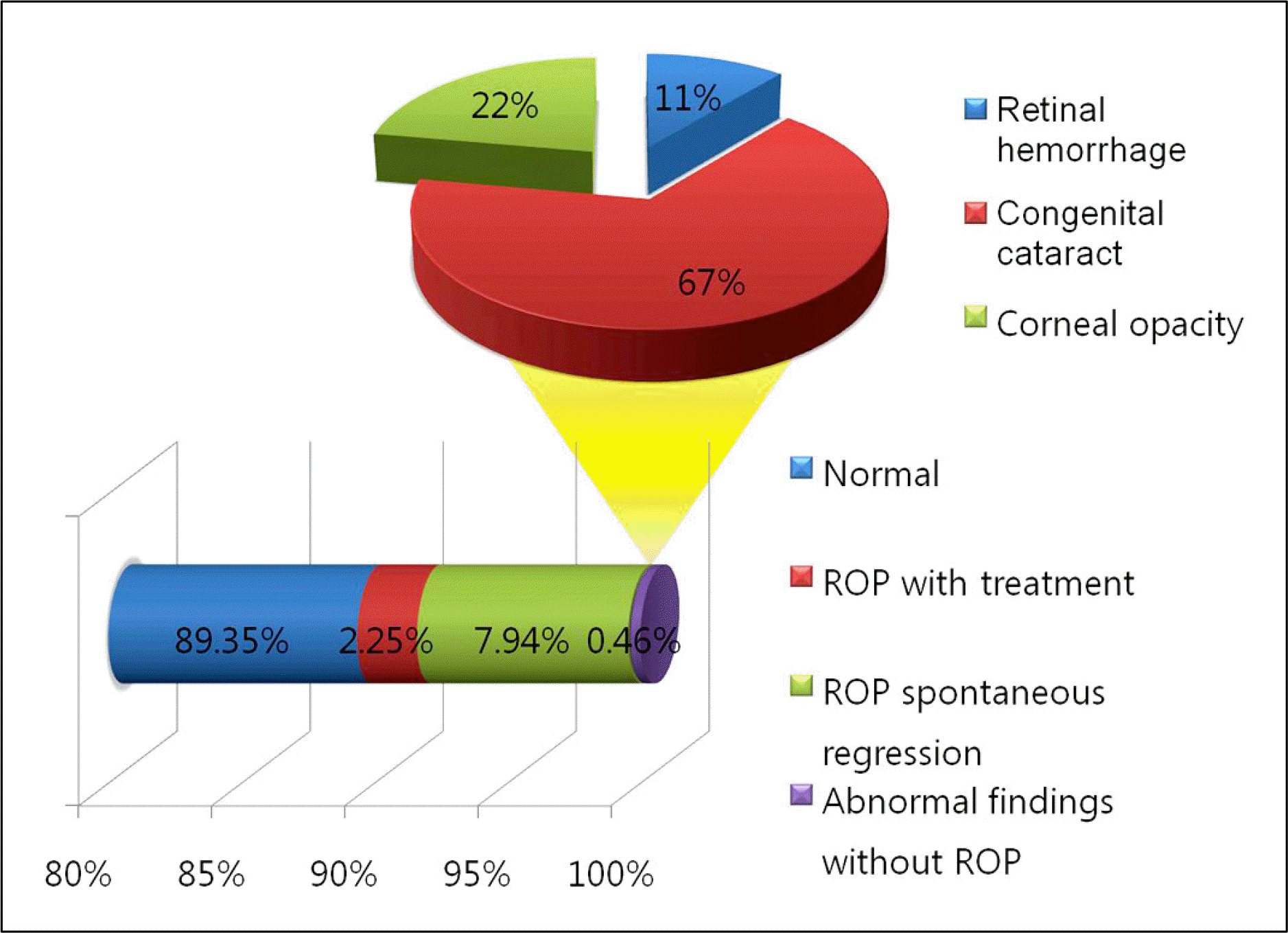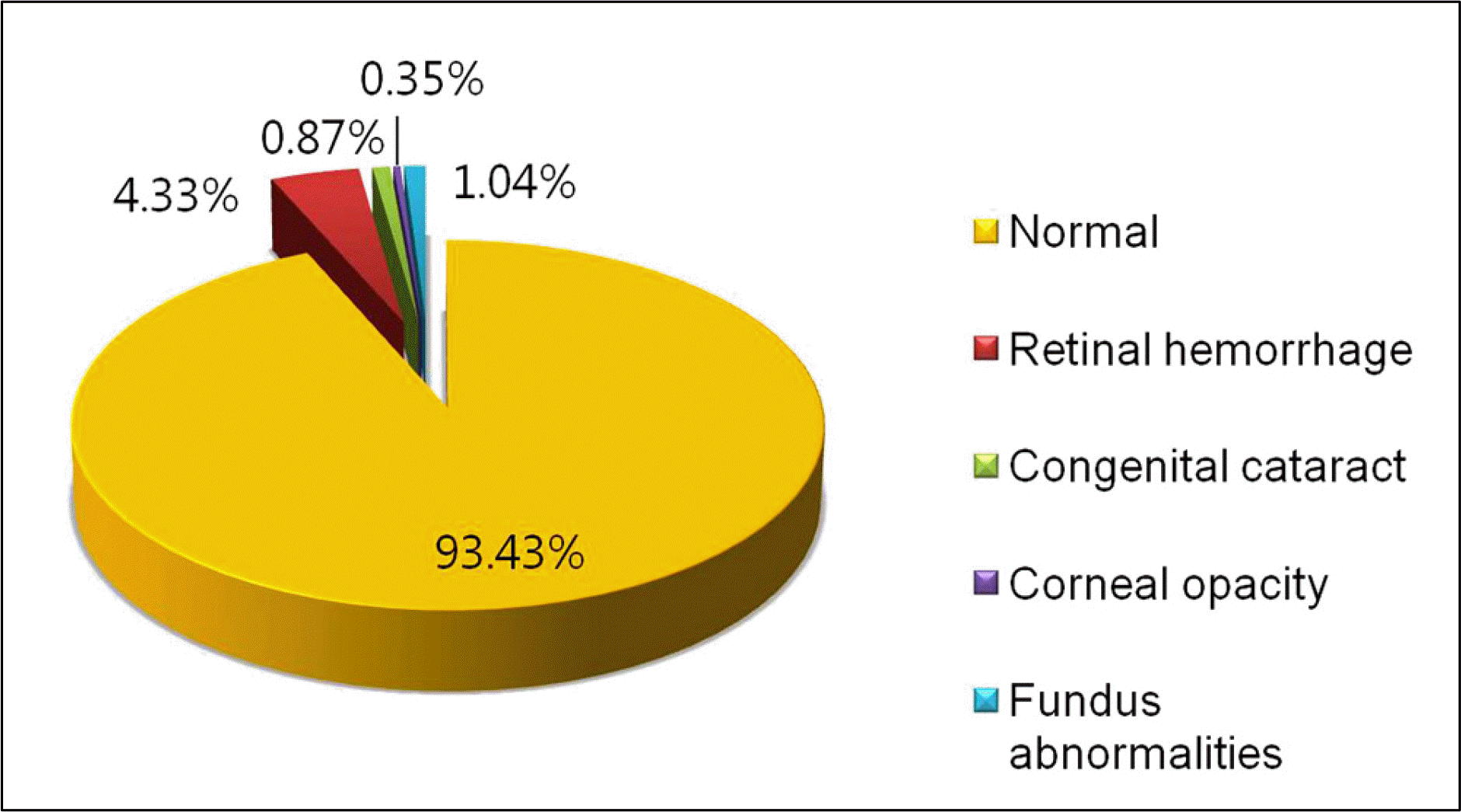Abstract
Purpose
To investigate incidental abnormal ocular findings that may cause visual impairment in neonates.
Methods
The medical records of patients requested for screening for retinopathy of prematurity (ROP) at our hospital's pediatrics department between March 2005 and July 2009 were retrospectively reviewed. Patients were classified into premature and mature neonates according to gestational age (under 37 weeks).
Results
A total of 2,090 eyes from 1,045 patients were comprised of 1,514 eyes of 757 premature neonates and 576 eyes of 288 mature neonates. Among 154 eyes of 78 patients (10.17%) who were diagnosed with ROP, 34 eyes of 18 patients had laser treatment. Seven eyes of 5 patients in the premature neonate group (0.46%), and 38 eyes of 23 patients in the mature neonate group (6.57%) were found to have abnormal ocular findings, excluding incidental ROP. Twenty-six eyes of 16 patients were found to have a retinal hemorrhage, and the majority had a birth history of perinatal distress, including birth asphyxia, meconium aspiration, and transient tachypnea of the newborn. Other findings included congenital cataracts, corneal opacity, macular coloboma, persistent hyperplastic primary vitreous, and abnormal fundus.
Conclusions
The incidence of ocular abnormalities in neonates that cause visual impairment is low, but theses may threaten a child's life. Early detection and prompt treatment of ocular disorders in children are important in order to avoid permanent, lifelong visual impairment. Therefore, ophthalmic examinations are essential, even in normal neonates, for early detection of ocular disorders.
References
1. Kvarnström G, Jakobsson P, Lennerstrand G. Screening for visual and ocular disorders in children, evaluation of the system in Sweden. Acta Paediatr. 1998; 87:1173–9.
2. Committee on Practice and Ambulatory Medicine, Section on Ophthalmology of American Academy of Pediatrics, American Association of Certified Orthoptists, American Association for Pediatric Ophthalmology and Strabismus; American Academy of Ophthalmology. Eye examination in infants, children, and young adults by pediatricians. Pediatrics. 2003; 111:902–7.
3. Choi KW, Koo BS, Lee HY. Preschool vision screening in Korea: results in 2003. J Korean Ophthalmol Soc. 2006; 47:112–20.
4. Lim HT, Park SH, Ahn H, et al. Preschool vision screening in Korea: results in the year of 2001. J Korean Ophthalmol Soc. 2003; 44:2318–27.
5. Mohney BG. Axial myopia associated with dense vitreous hemorrhage of the neonate. J AAPOS. 2002; 6:348–53.

6. Kvarnström G, Jakobsson P, Lennerstrand G. Visual screening of Swedish children: an ophthalmological evaluation. Acta Ophthalmol Scand. 2001; 79:240–4.

7. Hall DM, Eliiman D. Health for all children. 4th ed.Oxford: Oxford University Press;2006. p. 351.
8. Sotomi O, Ryan CA, O'Connor G, Murphy BP. Have we stopped looking for a red reflex in newborn screening? Ir Med J. 2007; 100:398–400.
9. American Academy of Pediatrics, Section on Ophthalmology, American Association for Pediatric Ophthalmology and Strabismus, American Academy of Ophthalmology, American Association of Certified Orthoptists. Red reflex examination in neonates, infants, and children. Pediatrics. 2008; 122:1401–4.
10. Bothun ED. Ten critical diagnoses not to miss on a pediatric eye screening. Minn Med. 2009; 92:34–7.
11. Tingley DH. Vision screening essentials: screening today for eye disorders in the pediatric patient. Pediatr Rev. 2007; 28:54–61.

12. Hård AL, Sjödell L, Borres MP, et al. Preschool vision screening in a Swedish city region: results after alteration of criteria for referral to eye clinics. Acta Ophthalmol Scand. 2002; 80:608–11.

13. Hård AL. Results of vision screening of 6-year-olds at school: a population-based study with emphasis on screening limits. Acta Ophthalmol Scand. 2007; 85:415–8.

14. Fulton A. Screening preschool children to detect visual and ocular disorders. Arch Ophthalmol. 1992; 110:1553–4.

15. Montes-Micó R, Ferrer-Blasco T. Distribution of refractive errors in Spain. Doc Ophthalmol. 2000; 101:25–33.
16. Lim HC, Quah BL, Balakrishnan V, et al. Vision screening of 4-year-old children in Singapore. Singapore Med J. 2000; 41:271–8.
Table 1.
Demographics in the premature neonate group
Table 2.
Demographics in the mature neonate group




 PDF
PDF ePub
ePub Citation
Citation Print
Print




 XML Download
XML Download